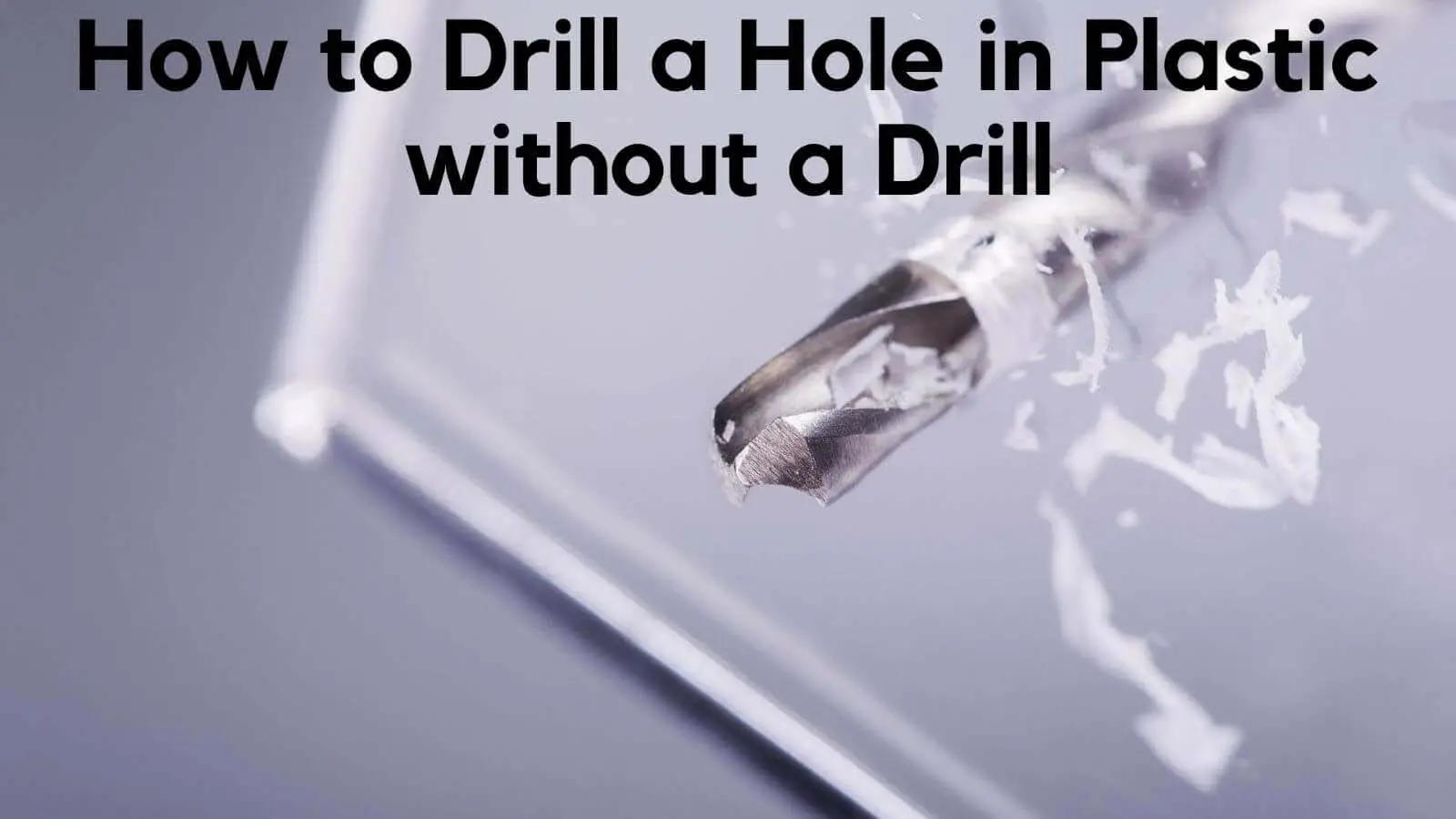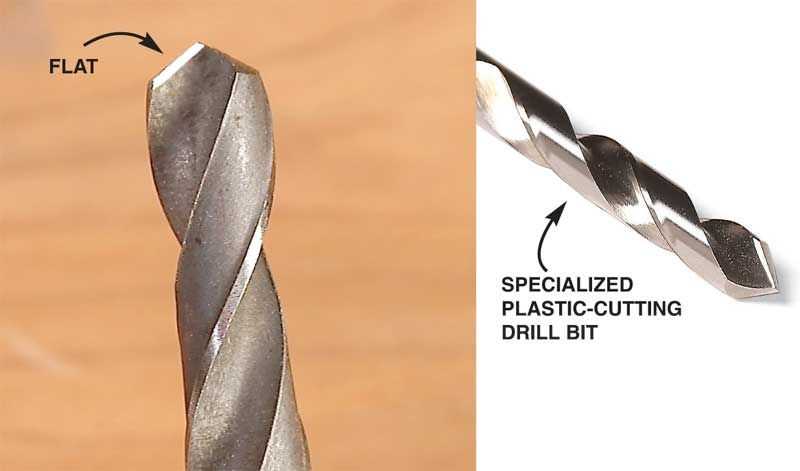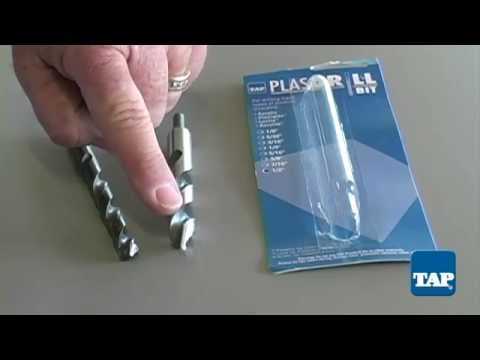Tips for Drilling into Plastic Materials

Drilling into plastic materials can be a delicate process, as plastic is prone to cracking, melting, or breaking if not handled correctly. Whether you’re installing hooks, creating drain holes, or working on a DIY project, it’s important to follow certain guidelines to ensure a clean and successful drilling experience.
Choose the right drill bit: When drilling into plastic, it’s crucial to select the appropriate drill bit. A high-speed steel (HSS) or a cobalt drill bit is recommended for drilling into plastic materials. These types of drill bits are designed to handle the plastic’s low heat resistance and prevent overheating or melting.
Use low drilling speed: To further prevent overheating or melting, it’s important to use a low drilling speed when working with plastic. Slow and steady wins the race when it comes to drilling into plastic materials. High drilling speeds can generate excessive heat, causing the plastic to melt or crack.
Apply steady pressure: Unlike drilling into other materials, such as metal or wood, drilling into plastic requires gentle and steady pressure. Applying excessive force can easily crack or break the plastic. Use a firm grip and let the drill do the work, rather than forcing it through the material.
Secure the plastic material: Before drilling into plastic, make sure the material is properly secured to prevent unnecessary movement. Using clamps or holding the material tightly can help keep it in place and reduce the risk of slipping or cracking during the drilling process.
By following these tips, drilling into plastic materials can be a successful and hassle-free endeavor. Remember to choose the right drill bit, use low drilling speed, apply steady pressure, and secure the plastic material. With the right approach and technique, you can achieve clean and precise holes in plastic materials without any complications.
Choosing the Right Drill Bit
When it comes to drilling into plastic materials, one of the most important factors to consider is the type of drill bit you use. Using the wrong drill bit can result in cracking, melting, or other damage to the plastic. Here are some tips for choosing the right drill bit for your plastic project:
- High-speed steel (HSS) drill bits: HSS drill bits are a good choice for drilling into plastic materials. They are durable, heat-resistant, and can be used on a variety of plastics.
- Carbide drill bits: Carbide drill bits are another option for drilling into plastic. They are extremely hard and can be used on harder plastics or for drilling at higher speeds.
- Brad point drill bits: Brad point drill bits have a sharp point and are designed to create clean, precise holes. They are a good choice for drilling into thin or fragile plastics.
- Countersink drill bits: If you need to create a countersink hole in your plastic material, a countersink drill bit is the right tool for the job. These drill bits combine the functions of drilling and countersinking in one step.
When choosing the size of your drill bit, it’s important to consider the thickness of the plastic material and the size of the hole you need to create. Using a drill bit that is too large can result in a larger-than-intended hole, while using a drill bit that is too small can cause the plastic to crack or break.
Before drilling into the plastic, it’s a good idea to mark the location of the hole and use a center punch to create a small indentation. This will help you keep the drill bit centered and prevent it from slipping.
Always use a slow drilling speed and apply gentle, consistent pressure when drilling into plastic. If the plastic material starts to melt or smoke, it’s a sign that you are using too much speed or pressure. In that case, it’s best to stop drilling and allow the plastic to cool down before continuing.
By choosing the right drill bit and following these tips, you can ensure a successful drilling experience with plastic materials.
Preparing the Work Surface
1. Clear the Surface
Before you begin drilling into plastic materials, it is important to clear the work surface of any debris or clutter. Remove any objects that could potentially interfere with the drilling process or pose a safety hazard. This will ensure a clean and organized work area.
2. Secure the Material
Next, securely fasten the plastic material to be drilled onto the work surface. This can be done using clamps or a vice, depending on the size and shape of the material. Ensuring that the material is held firmly in place will prevent it from shifting or moving during drilling, which can lead to inaccurate holes or damage to the plastic.
3. Mark Drill Points
Using a pencil or marker, mark the desired drill points on the surface of the plastic material. Take measurements and use a ruler or measuring tape to ensure accurate placement of these points. This step will help guide you during the drilling process and ensure that the holes are drilled in the correct locations.
4. Use a Backing Material
If the plastic material is thin or prone to cracking, it is recommended to use a backing material. This can be a piece of scrap wood or a block of plastic. Place the backing material underneath the area where the hole will be drilled to provide support and prevent the material from splitting or cracking under the pressure of the drill.
5. Lubricate the Drill Bit
Before drilling into the plastic material, apply a small amount of lubricant to the drill bit. This can be a general-purpose oil or lubricant specifically designed for drilling into plastic. Lubricating the drill bit will reduce friction and heat build-up, resulting in smoother drilling and reduced risk of melting or warping the plastic.
6. Wear Personal Protective Equipment
Prior to drilling, make sure to wear appropriate personal protective equipment (PPE). This may include safety glasses or goggles to protect your eyes from debris, and gloves to protect your hands. Plastic bits can chip or break during drilling, and PPE will help minimize the risk of injury.
Marking the Drill Points
Before you start drilling into plastic materials, it is important to properly mark the drill points to ensure accurate and precise drilling. Here are some tips on how to mark the drill points:
- Measure and mark: Use a measuring tape or ruler to determine the exact location where you need to drill holes. Measure and mark the points with a pencil or a scratch awl.
- Use a center punch: For more precise drilling, you can use a center punch to create a small indentation at the marked drill points. This will help prevent the drill bit from wandering or slipping when you start drilling.
- Mark with adhesive tape: Another method is to place a strip of adhesive tape over the drill points. You can then mark the center of the hole by making an X with a utility knife. This will help guide the drill bit to the exact location.
- Make pilot holes: If you are drilling larger holes or using a spade bit, it is often helpful to first make pilot holes with a smaller drill bit. These pilot holes will act as guides for the larger drill bit and help prevent cracking or splitting of the plastic material.
By properly marking the drill points, you can ensure that your drilling is accurate and avoids any potential damage to the plastic material.
Securing the Material

When drilling into plastic materials, it is important to securely hold the material in place to prevent any movement or sliding. This will help ensure accurate drilling and prevent any damage to the plastic.
Here are some tips for securing the material:
- Use clamps or a vise: Depending on the size and shape of the plastic material, you can use clamps or a vise to hold it securely in place. This will provide stability and prevent the material from moving during drilling.
- Use double-sided tape: If clamps or a vise are not suitable for your project, you can use double-sided tape to stick the plastic material onto a flat surface. This will help hold it in place and prevent it from shifting during drilling.
- Create a drilling jig: For recurring drilling tasks, consider creating a drilling jig. This is a template or guide that holds the plastic material in the exact position for each hole. It can be made from wood or plastic and will help ensure consistency and accuracy in your drilling.
By taking the time to secure the plastic material before drilling, you can avoid any mishaps or mistakes that could damage the material or compromise the integrity of your project.
Using the Right Drilling Technique
Drilling into plastic materials requires a different technique compared to drilling into harder materials like wood or metal. The following tips will help ensure successful drilling into plastic:
1. Choose the Right Drill Bit
When drilling into plastic, it’s important to use a drill bit specifically designed for plastics. These drill bits feature a sharp point and a high-speed steel or carbide construction, which allows for efficient drilling without causing damage or melting the plastic.

2. Start with a Pilot Hole
Before drilling the full-size hole, it’s recommended to start with a smaller pilot hole. This helps to guide the drill bit and prevent it from slipping or wandering across the surface of the plastic. Use a drill bit slightly smaller than the desired hole size for the pilot hole.
3. Use Low Speed and Minimal Pressure
When drilling into plastic, it’s best to use a low drill speed to avoid generating excessive heat. High speeds can cause the plastic to melt or warp. Additionally, apply only minimal pressure to the drill to prevent cracking or splintering of the plastic.
4. Secure the Plastic Material
Before drilling, make sure to securely clamp or hold the plastic material in place. This prevents it from moving or vibrating during drilling, which can lead to inaccurate holes or damage to the material. Consider using a vise or grip clamps to keep the plastic steady.
5. Drill in Short Bursts

Instead of drilling continuously, it’s recommended to drill in short bursts. This helps to dissipate heat and prevent the plastic from melting or warping. After drilling for a few seconds, stop and allow the drill bit and plastic to cool down before continuing.
6. Use a Backing Material
For thin or flexible plastic materials, it’s advisable to place a piece of scrap wood or another backing material behind the plastic. This prevents the plastic from cracking or shattering when the drill bit exits the material.
7. Clear the Drill Bit Regularly
Plastic materials can tend to stick to the drill bit, causing it to clog and reduce drilling efficiency. To prevent this, regularly clear the drill bit by back-spinning or stopping the drill and removing any plastic debris. This helps to maintain a clean cutting surface and prevent overheating.
By using the right drilling technique, you can effectively drill into plastic materials without causing damage or compromising the integrity of the plastic. Always take the necessary precautions and follow these tips for successful drilling results.
Applying Proper Pressure
When drilling into plastic materials, it is important to apply the proper amount of pressure. Too much pressure can cause the plastic to crack or break, while too little pressure may result in the drill bit not making any progress.
Here are some tips for applying the proper pressure when drilling into plastic materials:
- Start with a light touch: Begin drilling with a light touch and slowly increase the pressure as needed. This will allow you to gauge how easily the plastic is being drilled into without applying excessive force.
- Use a drill bit with a fine point: A drill bit with a fine point will provide better control and reduce the likelihood of the drill bit slipping or digging too quickly into the plastic.
- Keep the drill steady and straight: Maintain a steady and straight position when drilling into the plastic. Applying pressure from an angle or allowing the drill to move around can increase the likelihood of the plastic material breaking or cracking.
- Use a slow drilling speed: It is recommended to use a slow drilling speed when working with plastic materials. This will reduce the risk of the plastic melting or warping due to excessive heat generated by high-speed drilling.
- Take breaks if needed: If you feel that the plastic material is getting too hot or the pressure you are applying is causing excessive stress, take breaks and allow the plastic to cool down before continuing.
By following these tips and techniques, you can apply the proper amount of pressure when drilling into plastic materials, ensuring a successful and safe drilling experience.
Cooling the Drill Bit
Drilling into plastic materials can generate heat, which can cause the plastic to melt or deform. To prevent this, it is important to cool the drill bit during the drilling process. Here are some tips to help you cool the drill bit effectively:
1. Use a Lubricant
Applying a lubricant, such as oil or cutting fluid, to the drill bit can help reduce friction and heat buildup. This allows the drill to cut through the plastic more smoothly and keeps the temperature down. Make sure to choose a lubricant suitable for use with plastic materials.
2. Drill at Low Speed
Using a high speed setting on your drill can generate more heat. To prevent overheating, lower the speed of your drill when drilling into plastic materials. This will help reduce friction and give you better control over the drilling process.
3. Take Breaks

If you’re drilling multiple holes or drilling for an extended period of time, it’s a good idea to take breaks. This allows the drill bit to cool down and prevents it from becoming too hot. Taking breaks also prevents the plastic from melting or deforming due to excessive heat.
4. Use a Cooling Fan
Using a cooling fan or an air compressor can help blow air onto the drill bit, cooling it down. This is especially useful when drilling through thick or hard plastic materials. Position the fan or air compressor so that it directs the airflow towards the drill bit for maximum cooling effect.
5. Use a Drill Bit with Cooling Channels
Some drill bits are specifically designed with built-in cooling channels. These channels allow air or coolant to flow through the bit, keeping it cool during the drilling process. Consider using these specialized drill bits when drilling into plastic materials.
6. Keep the Drill Bit Sharp
A dull drill bit generates more heat due to increased friction. Make sure to keep your drill bits sharp by regularly sharpening or replacing them. A sharp drill bit will cut through the plastic more easily and generate less heat.
By following these tips, you can effectively cool the drill bit when drilling into plastic materials. This will help prevent melting or deformation of the plastic and ensure a successful drilling process.
Cleaning Up the Work Area
After drilling into plastic materials, it is important to clean up the work area to ensure a safe and productive environment. Here are some tips for cleaning up the work area:
- Remove any plastic debris: Use a brush or vacuum to remove any plastic debris that may be left behind after drilling. This will help prevent any accidents or injuries caused by slipping on plastic pieces.
- Dispose of plastic waste properly: Place all plastic waste in a designated container for proper disposal. This will help minimize the impact on the environment and ensure that the waste is handled appropriately.
- Clean drilling tools and equipment: Thoroughly clean drilling tools and equipment to remove any plastic residue. This will help maintain their performance and lifespan.
- Organize the work area: Arrange the work area in a neat and orderly manner. This will make it easier to find and access tools whenever they are needed, reducing the chances of accidents or misplacements.
- Store plastic materials properly: If there are any remaining plastic materials, store them in a dry and organized area. This will help prevent damage and ensure that the materials are ready for future use.
By following these tips, you can ensure that your work area remains clean, organized, and safe after drilling into plastic materials.
FAQ:
Can I use a regular drill bit to drill into plastic?
Yes, you can use a regular drill bit to drill into plastic. However, it is recommended to use a drill bit specifically designed for plastic to avoid any damage or cracking.
What type of drill bit is best for drilling into plastic?
The best type of drill bit for drilling into plastic is a spiral flute drill bit. These drill bits have a unique shape that helps to reduce the chances of chipping or cracking the plastic material.
What should I do to prevent melting the plastic while drilling?
To prevent melting the plastic while drilling, it is important to use a slow drill speed and apply light pressure. It is also recommended to use a spray bottle filled with water to cool down the drill bit and the plastic as you drill.
How do I ensure clean and precise holes when drilling into plastic?
To ensure clean and precise holes when drilling into plastic, it is recommended to start with a small pilot hole before using a larger drill bit. This will help to guide the larger bit and prevent the plastic from cracking or splintering. It is also important to use a steady hand and apply consistent pressure while drilling.
Video:










